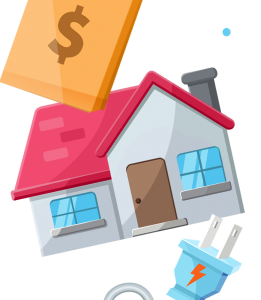Taxation Overview
Taxes are everywhere and are essential in keeping the modern world functioning. For your personal finances, taxes also play a huge role in your financial decision-making. While we have lessons that cover most major types of taxes in detail, to get started we want to give the “big picture” of the types of taxes, and what their impact is on your financial life.
Progressive versus Regressive Taxes
Taxes impact different people in different ways, and economists can classify different types of taxes based on whether they are Progressive or Regressive.
Progressive Taxes
A “Progressive” tax is designed so that the more money you earn, the bigger percentage tax you pay. The clearest example of a “Progressive” tax is federal income tax in the United States. This is the “tax bracket table” as of 2024:
| Rate | For Single Individuals | For Married Individuals Filing Joint Returns | For Heads of Households |
| 10% | Up to $11,600 | Up to $23,200 | Up to $16,550 |
| 12% | $11,601 to $47,150 | $23,201 to $94,300 | $16,551 to $63,100 |
| 22% | $47,151 to $100,525 | $94,301 to $201,050 | $63,101 to $100,500 |
| 24% | $100,526 to $191,950 | $201,051 to $383,900 | $100,501 to $191,950 |
| 32% | $191,951 to $243,725 | $383,901 to $487,450 | $191,951 to $243,700 |
| 35% | $243,726 to $609,350 | $487,451 to $731,200 | $234,701 to $609,350 |
| 37% | $609,350 or more | $731,200 or more | $609,350 or more |
What this means is that if you are a single person, your first $11,600 is taxed at 10%, then from $11,601 to $47,150 you are taxed at 12%, from $47,151 to $100,525 you are taxed at 22%, and so on. The more you earn, the more you are taxed. From this table, if you earn $125,000, your tax will break down to:
- First $11,600 taxed at 10%
- $1,160 tax
- $113,400 moves up to the next bracket
- The next bracket is $11,601 to $47,150, or your next $35,500. This is taxed at 12%
- $4,266 tax
- $77,850 moves up to the next bracket
- The next bracket is $47,151 to $100,525, or your next $53,357. This is taxed at 22%
- $11,742 tax
- $24,475 moves up to the next bracket
- The next bracket is the money you made over $100,526, meaning that last $24,475. This is taxed at 24%.
- $5,874 tax
This would make your total income tax $1,160 + $4,266 + $11,742 + $5,874 = $23,043 (or about 18% of your total income).

If you only earned $8,000 for the year, it would just be $8,000 taxed at 10%, so you can see that as your income goes up, so does your tax rate.
This type of tax is usually popular, as it shifts most of the tax burden onto people who can most easily afford to pay it (while giving the poor a tax break).
Regressive Tax
A “Regressive” tax is the opposite, the smallest earners pay the biggest percentage of tax. An example of a “Regressive” tax is a sales tax, where you pay a flat percentage fee on everything you buy. This might not sound regressive at first, but consider our two earners from the example above, with a 5% sales tax.
- Our $100,000 earner saves 30% of their earnings, between their investments and their retirement account. They only spend $70,000 per year.
- A 5% sales tax on $70,000 is $3,500.
- This comes out to a 3.5% tax on their total earnings.
- Our $8,000 earner is too poor to set aside any money for savings. They spent all $8,000 that they earned.
- A 5% sales tax on $8,000 is $400
- This is exactly 5% of their total earnings
Our “richer” person is paying a lower total percent tax than our poorer earner, which is what makes this tax “regressive”. All “use taxes”, like vehicle registration fees, gasoline taxes, sales taxes, taxes on cigarettes and alcohol, and even things like fishing permits are “regressive” taxes.

Regressive taxes are also popular in all the examples outlined above because it shifts the burden of the taxes on the people who use these services. For example, gasoline taxes are used to fund road maintenance, which means people who buy the most gas (and use the roads the most) pay more for their maintenance.
Taxes on Your Financial Decisions
Your potential tax burden can have a major impact on your financial decisions as well because lawmakers design tax structures to encourage certain types of activity and discourage others. Some examples of this include:
Capital Gains Taxes
“Capital Gains” tax is the tax placed on appreciated assets. A clear example of this is the profit earned from investing in stocks.
Capital Gains taxes are structured with two rates, a “Short Term” rate for profits earned in less than a year, and a “Long Term” rate for profits earned over more than a year. What determines the timeline is when you sell your asset and collect the cash profit, not just how much the stock goes up in value while still in your portfolio. In 2024, these were the capital gains tax rates for a single person (note that this is a “Progressive” tax, so the rate increases as profit increases)

Tax Rates for Short-Term Capital Gains
If you have profits from short-term capital gains, it is treated as regular income when filing your taxes – so it gets added to your other income and uses the same tax rates.
Tax Rates for Long-Term Capital Gains
| 0% rate | 15% rate | 20% rate |
| Up to $47,025 | $47,026 to $518,900 | Over $518,900 |
The government likes to encourage long-term investments, particularly as part of a retirement plan, so low profits are not taxed at all. On the contrary, high profits are taxed at a MUCH lower rate.
As an investor, this can have a major impact on your investing decisions. Encouraging long-term investing means that you would be less likely to sell off a stock just because it has one or two “bad days” because the short-term capital gains tax would eat into your profits. If you hold a stock for more than a year before selling it, you get to keep a lot more of your profits.
Sales Taxes
Sales taxes can also discourage your purchases or encourage you to make your purchases elsewhere. For example, most cities have high sales tax rates, which adds extra expenses to every purchase. Many suburban areas (just outside the cities) have many “outlet malls”, where retailers set up shop just outside the city to lure shoppers out for the lower prices (purely due to lower sales tax).
Cities also put higher taxes on vehicles in suburban and rural areas. This is specifically to discourage people from buying cars and clogging up the roads and to encourage people to share rides or use public transit.
Property Taxes
Property taxes are taxes on personal property, usually a house or land. Property Taxes are a major consideration when real estate investing. Usually, your personal home is taxed at a lower rate, but if you buy another property to rent out it gets taxed at a higher rate. This is set up to encourage people to own their own homes and encourage people who own rental properties to sell them to another buyer.
Now that we have some idea of how taxes are designed and how they can impact your personal finances, the next lessons have more of a deep dive into individual tax types and how they work.
